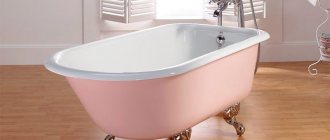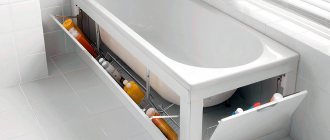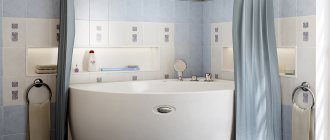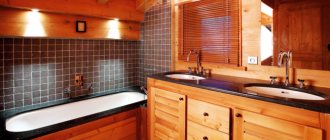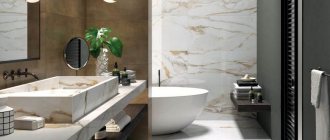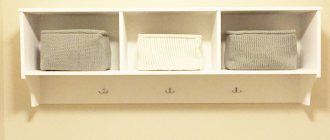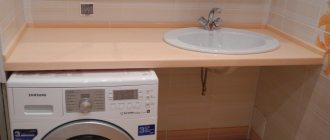Criterias of choice
Let us highlight several important characteristics with which you can compare plumbing fixtures.
- Life time. This indicator affects the durability of the selected bath. If you purchase a cheap product, then in the long run the savings will turn into additional expenses. The longer the bathtub lasts, the less you will have to spend subsequently: on repairs, dismantling, purchasing and installing a new bathtub.
- Care and cleaning. The bathtub has to be washed daily, so caring for it turns into a grueling task if the material is too fancy. Ease of care depends on the composition and thickness of the enamel covering the surface of the product.
- Variety of shapes and sizes. Bathrooms of different sizes require different bath models: you need to take into account the width, length, height and shape of the product. Sometimes a small or asymmetrical bowl is the only way to comfortably accommodate all the necessary items in a cramped bathroom. There are not only standard rectangular fonts on sale, but also angular, multifaceted, round and shaped products.
- Practicality. The bathtub should not deform from exposure to hot water and sag under a person during use. This also includes the ability to withstand mechanical stress.
- Convenience. This criterion is responsible for comfort during water procedures: how long does the tank keep warm? Does the bowl make more noise when filling the bathtub? Is it possible to install additional options such as hydromassage and water level sensor?
- Installation. Some products are easy to install and connect yourself, but in other cases you will have to spend money on a specialist. Also, some bowls require additional metal legs or a frame.
- Weight. Most often, this indicator is paid attention to when purchasing a cast iron bathtub. A heavy product makes transportation and installation difficult. Before purchasing, you should consider the details of delivery: will you need a special car and loaders? Will the tank fit in the elevator? If the weight of the bathroom is high, then transportation becomes an additional expense.
- Price. For many buyers, the cost of the product is the main factor when choosing a bathtub. The problem lies in the fact that with this approach the design may not meet even minimal expectations and will soon lose its appearance.
Installation features
When installing a cast iron structure, its weight becomes a big problem. It is impossible even for a person in excellent physical shape to install a bathtub alone. But the massiveness is also an advantage of the product, since the bath remains stable without additional fastening. It is enough to install it in the right place and connect the drain.
Steel models are not as heavy. Otherwise, their installation does not differ from cast iron structures. The legs are secured, the drain is screwed on, and the bathtub is put in place. If a location other than the walls is chosen for installation, then additional measures are taken to prevent the bath from moving during use.
Cast iron bath
This material has remained in demand for several decades. Bathtubs made of cast iron are reliable, as they are made of durable, high-quality alloy. The top of the product is covered with a double or triple layer of enamel. Cast iron bowls are not distinguished by a variety of sizes: Russian companies make tanks with a maximum length of 150 cm, and foreign companies increase them to 180 cm. The standard width of a cast iron bath is 70 cm, but there are also 90 cm.
Peculiarities
The main difference between cast iron bathtubs and steel and acrylic ones is the wall thickness, which reaches 10 mm and makes the product heavier. The finished bowl weighs about one hundred kilograms. On the one hand, this provides the tank with strength and stability, but on the other, it significantly complicates its transportation and installation. Install a heavy bath only on concrete and reinforced concrete floors. If the house has wooden floors, it is better to refuse a cast iron bowl. When choosing, you should pay attention to the walls of the tank - the coating should be smooth to the touch, uniform, without bumps or chips.
If the enamel layer is sufficiently thick, then using a special polishing agent it is not difficult to restore a cast iron bathtub: you can get rid of scratches and small cracks. For more complex cases, specialists are invited.
Advantages and disadvantages
Let us highlight the main advantages and disadvantages in accordance with the selected criteria:
| pros | Minuses |
| A cast iron bathtub cannot be called eternal, but it lasts a long time - from 30 years with proper handling. Some manufacturers claim that the product can last more than 50 years. To prevent cracks from forming on the enamel, you should protect it from impacts with heavy objects (a chip can appear from a falling shower head or metal bucket). | Cast iron bathtubs come in a variety of designs. Production features do not allow us to produce bowls longer than 1.9 m. |
| High-quality enamel on the surface of the walls allows the use of even aggressive cleaning agents and mechanical action, but such methods are required only for difficult to remove stains. For daily care, soft sponges and compounds without abrasives and acids are used. | The weight of the product makes it stable, but requires help when transporting and installing the bowl. It must be placed on a flat floor (preferably lined with ceramic tiles). The product comes with special legs or “lion paws”, which give the cast iron bath an elegant look. |
| The material is not sensitive to temperature changes and does not deform under the weight of a person. You can also wash pets in a cast iron bowl - there will be no scratches on the enamel. | Not everyone can afford a cast-iron bathtub - the price of high-quality bathtubs starts from 20 thousand. |
| The walls of the cast iron bathtub have good sound absorption. Also, the material does not allow the water to cool quickly, which is quite important for those who like to soak in hot water longer. If desired, you can find a model with additional options. |
Installation types
There can be three options: installation along one of the walls (the most common), corner placement and installation in the middle of the room. The latter option is used for large bathrooms when using large oval or round bathtubs. Which are often equipped with hydromassage and other pleasant extras.
Corner models are produced both symmetrically and with different sizes of sides adjacent to the walls. As a rule, the side opposite the corner is rounded. It is not only practical, but also looks beautiful.
Cast iron bathtubs, as a rule, are placed along the wall, less often they are placed in the center of the room. Due to the design features, they cannot be installed in a corner. As for steel and acrylic products, they can be mounted in any of three options. Finding the right model is not a problem.
Acrylic bath
Steel bath
Cast iron bath
Results. Once again we have two leaders - steel and acrylic products have more options regarding the type of installation. The cast iron baths remained in the shadows.
Acrylic bath
Bowls made of acrylic (methyl acrylate) appeared relatively recently, but quickly gained popularity. Bowls are produced in two ways: from a solid acrylic sheet, which is given the desired shape, or by injection using a fiberglass base. The second technology allows for a more durable product, which is why most people look for cast acrylic bowls. Minor damage to them can be eliminated with your own hands by using grinding and a special paste.
Peculiarities
The main difference between acrylic bathtubs is the lightness and pliability of the material. Modern buyers are attracted by the opportunity to choose almost any shape and size of bowl, and, if desired, order an individual product for specific needs. This is most relevant if there are elderly people or children living in the house, who find it convenient to use the built-in seat and handles. But it should be taken into account that an overly complex configuration reduces the reliability of an acrylic bathtub, and if additional functions such as hydromassage are built into it, then the costs of water, electricity and maintenance increase.
When choosing a finished bowl, you should check the thickness of the walls, which should be more than 4 mm: the fact that the manufacturer has saved on material is indicated by the ringing sound when tapped and the light passing through the sides.
Acrylic is a non-porous material, so dirt does not stick to the glossy walls. Also, plastic is not susceptible to rust and fungus, but the surface still needs to be looked after regularly. To do this, the acrylic bathtub is wiped with a soft sponge with soap or a special solution (no need to rub hard), rinsed with warm water and wiped dry. If you have not used the detergent before, it is recommended that you test it on an inconspicuous area first.
Advantages and disadvantages
Let's take a closer look at the advantages and disadvantages of acrylic bathtubs:
| pros | Minuses |
| The service life of a quality product is about 15 years. Cheap models usually don't last long. | Hard brushes, abrasives and acids are contraindicated when cleaning an acrylic bathtub, otherwise the glossy layer can be erased. Special “acrylic-friendly” compositions are used. |
| The plasticity of the material allows you to make any bowl shape. Dyes are added to some products, so acrylic bathtubs may vary in color. | |
| The bathtub is silent when filling. It has low thermal conductivity - water retains heat for a long time. For a more comfortable bathing experience, you can choose a product with hydromassage, but it will cost much more. | |
| You can handle the installation of an acrylic bathtub yourself, despite the fact that the tank is mounted on a metal frame. | The bottom may sag during use. The bathtub should not be filled with water at too high a temperature. |
| The weight of the acrylic bathtub is no more than 25 kg, which makes it easier to transport. But a bowl that is too weightless should alert you - probably the manufacturer skimped on material, which will have a bad effect on its service life. | |
| The cost of inexpensive bathtubs is about 7 thousand, high-quality products will cost many times more. |
Steel bath
Until acrylic bowls entered the market, steel bathtubs competed with cast iron bathtubs for a long time. They are more environmentally friendly and quite durable, although they are made from sheets only 0.35 cm thick. Modern enamel coating increases their reliability. You can also find products with thin sides (1.5 mm), but it is better to give preference to a more solid design with a thickness of at least 2.4 mm.
Peculiarities
A characteristic feature of a steel bath is its low price, which is achieved through complete mechanization of production and the minimum cost of raw materials. Another important difference from cast iron and acrylic bathtubs is rapid cooling. Also, the surface heats up instantly, which allows you to shower immediately without waiting for a temperature that is pleasant for your feet. But we attribute high thermal conductivity to the disadvantages of steel products, because the main purpose of the bowl is relaxation and comfort during long periods of lying in water. Ultimately, of course, it is up to the owners to decide.
To check the weight of the product in the store, you can lightly press on it: if the steel bathtub moves easily, the manufacturer made it too thin. It is also worth carefully inspecting the coating: it should be solid, uniform, without flaws or unnecessary inclusions.
Advantages and disadvantages
What are the advantages and disadvantages of steel bathtubs? Let’s consider further:
| pros | Minuses |
| The service life of a steel bath can be up to 30 years. To restore the product, special damage repair kits are sold. | Quite thin enamel can be damaged by careless cleaning. It will be expensive to restore the resulting defects. But if the steel bowl is coated with a special composition “Enamel-plus”, then caring for the surface is simplified several times. Unfortunately, products with such a coating can hardly be called budget. |
| Like acrylic bathtubs, steel ones come in a wide range of different shapes. | The bathtub can become deformed under a heavy person and crack. |
| Installation of the product is not difficult; one person can do it. Installation of steel bathtubs is technically considered the simplest. | Steel sides increase noise when drawing water. This can be combated with special stickers for the outer surface of the bathtub. Some owners simply fill it with polyurethane foam: in addition to reducing noise, this method helps the product retain heat longer. Also, thin walls do not allow the font to be equipped with additional options. |
| The maximum weight of a steel bowl is 30 kg; it is two or even three times lighter than a cast iron bowl. | |
| Low cost: prices for budget hot tubs start at 4 thousand. |
Comparing steel and cast iron: important characteristics
Cast iron is produced by fusing iron and carbon. This material has been used to make bathtubs since the 19th century. It is characterized by high strength, but at the same time brittleness due to the high percentage of carbon. Cast iron is resistant to corrosion even with constant simultaneous exposure to moisture and oxygen. If rust forms, it is on the surface, without penetrating inside. The material has good casting characteristics. Fonts are made from the alloy, which are coated with powder paint on the outside and layers of enamel on the inside to increase durability.
Steel is also an alloy of iron and carbon, but with less carbon content compared to cast iron. This makes the material more flexible, ductile and reduces its fragility. Stainless steel has the same corrosion resistance as cast iron. But for the production of bathtubs they use structural steel, which is protected from external damage with a special enamel coating.
Due to its flexibility, steel can be stamped, which makes it possible to diversify the choice of shapes for manufactured plumbing structures.
comparison table
After analyzing the above facts, it is easy to create a visual table reflecting all the properties of the products being compared. Buy a hot tub with those features that you attach the most importance to in everyday life.
| Options | Cast iron | Acrylic | Steel |
| Durability | + | +/- | + |
| Easy care | + | — | +/- |
| Variety of shapes and sizes | — | + | + |
| Practicality | + | + | — |
| Convenience | + | + | — |
| Easy installation | — | + | + |
| Light weight | — | + | + |
| Low price | — | +/- | + |
Which bath is better: conclusions
Here are a few reasons why you can easily decide on the choice of material for your bathroom:
- If the main requirement for a tank is its size or unusual shape, then acrylic and steel are suitable. In a small bathroom, it is more rational to install a corner or asymmetrical bowl, thereby saving valuable centimeters. Cast iron hot tubs are mostly presented in a standard design.
- If there are pets in the house, or rather large dogs that need to be washed after every walk, then the obvious choice is cast iron or steel. Unlike acrylic products, the enameled coatings of cast iron and steel bowls are not afraid of claws and street dirt.
- If the bathroom has a large area and the owner dreams of a spacious plunge pool, it is worth choosing an acrylic design. The shape can be any, and light and durable plastic will withstand the maximum volume of water.
- If the budget is limited, then between a cheap acrylic and a steel bathtub, preference should be given to the latter, since steel has a long service life, does not turn yellow and can withstand mechanical stress.
- If “indestructibility” and reliability are important, then it is recommended to choose a cast iron bowl. A product of excellent quality is installed “for centuries”: once spent, the owner will not think about replacing the tank for a long time.
- If comfort comes first, then the best option is an acrylic bathtub. Ultra-modern models with lighting and turbo massage not only look impressive, but also allow you to create a personal spa in your bathroom.
When choosing a bathtub, it is important to weigh all the pros and cons of different materials and purchase a durable, high-quality product from a reputable manufacturer. If the production technology is followed in the manufacture of the font, then the bowl - steel, acrylic or cast iron - will last a long time, without causing unnecessary trouble and giving pleasant emotions during use.
Appearance and design features
The characteristics of cast iron and the casting process do not provide much room for design experimentation. Cast iron bathtubs are produced only in the classic shape - oval, rectangular, you can find models with sides or a back.
The shape of a steel sheet is given by stamping. Which expands design possibilities. The most common are bathtubs of traditional designs, but in general the range is much wider. Steel allows you to make a structure of almost any shape, even a non-standard one.
